Marbled Rye Bread Made With Fresh Milled Flour
This marbled rye bread made with fresh milled flour is so fresh and aromatic! This recipe is such an enjoyable one to make because you get to roll up the two layers, slice into the dough, and then reveal a stunning, unique design each time. I start with a single dough, divide it in half, and then mix in a few extra ingredients to create the darker swirl. So, follow the recipe as written for a beautiful marbled Rye loaf, or make a loaf entirely with the light dough for a traditional rye bread. But, if you are craving a more robust flavor, then you can use all the dark dough for a rich, hearty rye. So, If you love a flavorful Reuben sandwich or a perfectly grilled melt, this bread is just what you need!
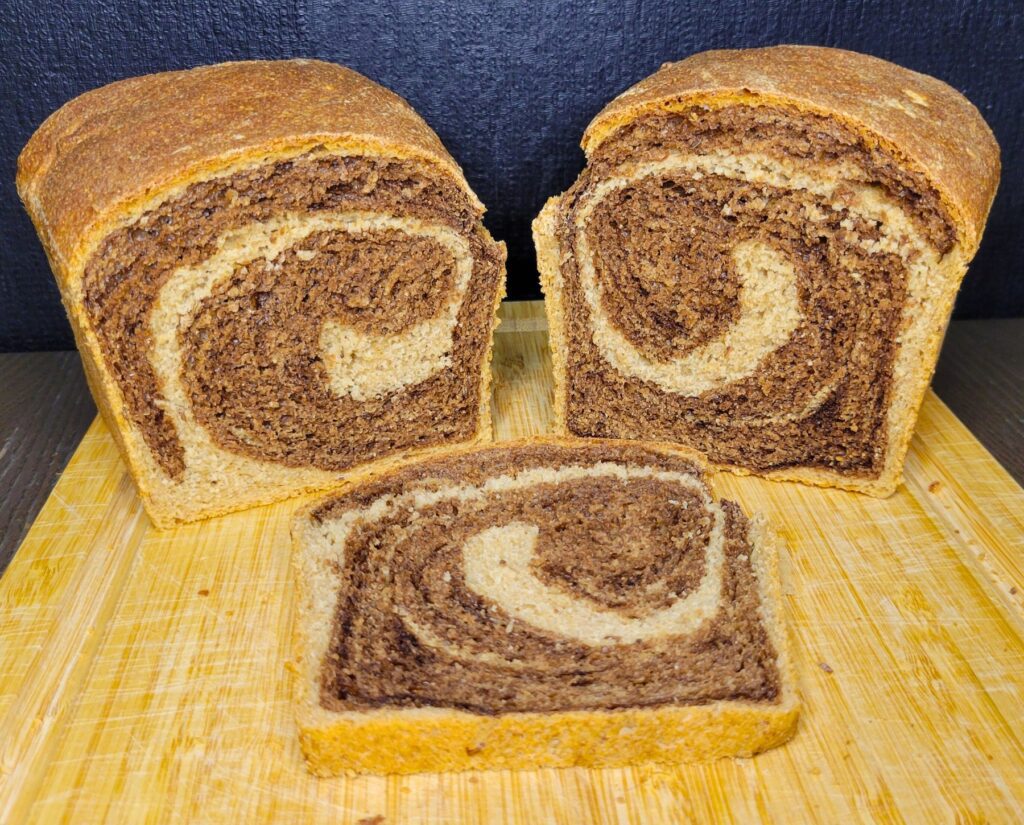
What Wheat Berries Do I Use To Make Marbled Rye Bread With Fresh Milled Flour?
To make marbled rye bread, you want to use mostly a hard wheat. This is because the hard wheat will allow for gluten formation which will give you nice stretchy dough, which in turn make a nice soft loaf of bread. So, I like to use a hard white wheat with a little Rye. But, you could also use a hard red wheat with a little rye as well. To make this change, you may need to increase the amount of hard red by just a bit.
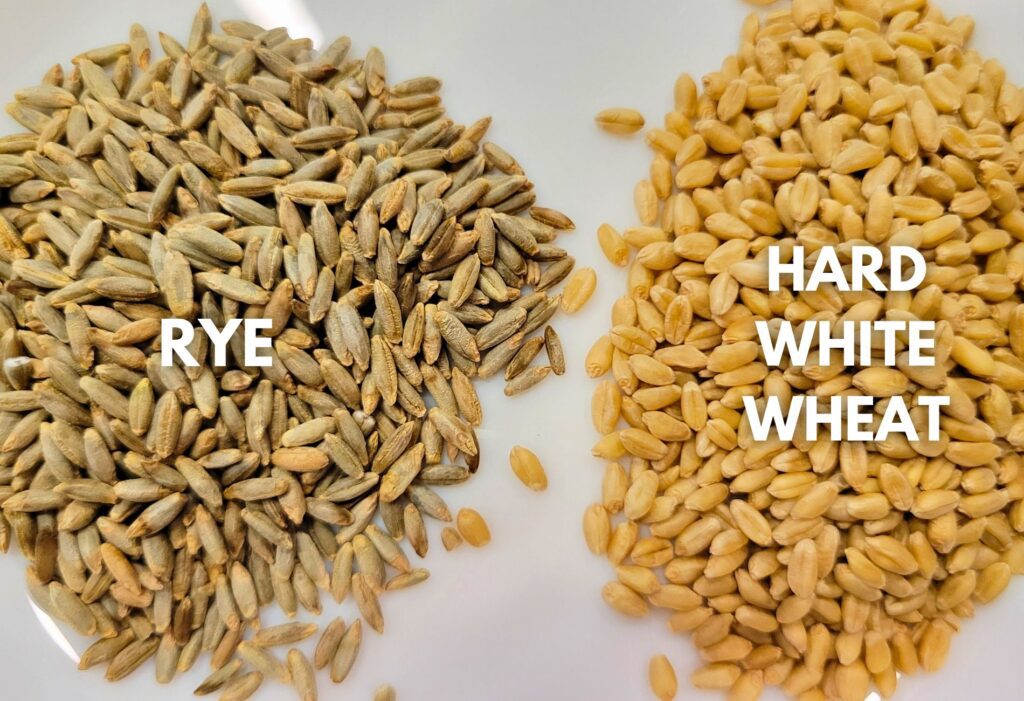
Hard White Wheat VS Whole Rye Berries
I wanted to just show you up close the difference in how the hard white wheat looks vs the whole Rye berries. How beautiful all these whole grains are. I love being able to mill my own flour, and have so many options to choose from. Each grain yields it’s own flavor, color, aroma, and texture. So, play around with them in blends when you have a recipe that you know and love. That way you can experience all these differences, and then decide what grains you prefer for which breads and baked goods. I could go on all day about this, but I want to stick with the recipe at hand for now.
I do have a post & video all about the different common wheat varieties and what to use them for, HERE is my wheat berry post. To watch my video, you can see that HERE.
What Gives Rye Bread That Strong Flavor?
What is the flavor of Rye bread, have you ever wondered that? Well, surprisingly, the flavor that you think of when you think of Rye Bread is not Rye at all. The “Rye” taste you have come to know and love is actually Carraway seeds. You can adjust this recipe to have no carraway seeds for a very mild and beautiful bread. OR increase the Carraway seeds to 3 TBSP for a strong aromatic rye! Play with the amount, and see what your family’s favorite way is.
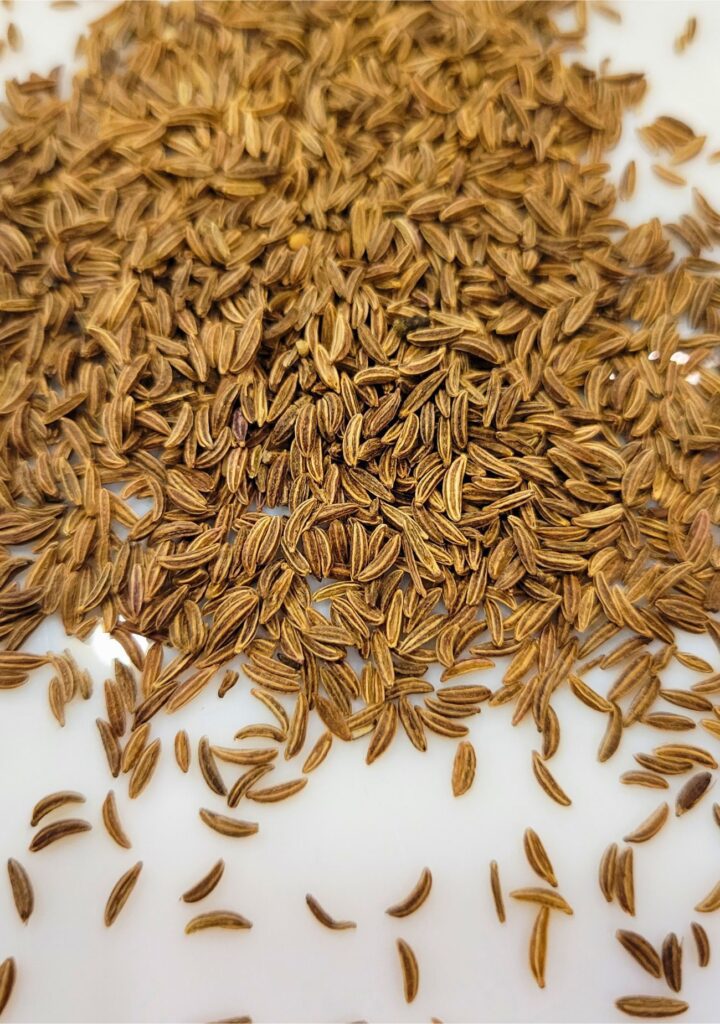
Ideas To Make With Fresh Milled Flour Marbled Rye Bread
While Marbled Rye Bread seems to be most known for a delicious Reuben sandwich however, here are some other great ideas of ways to enjoy it:
- Grilled Cheese – The rich flavor pairs perfectly with melty cheese.
- Avocado Toast – A hearty twist on a classic favorite.
- Toast – Top with butter, honey, or jam for a sweet start.
- Croutons – Cube and toast for a bold addition to salads or soups.
- Deli Sandwiches – Load it up with turkey, pastrami, or roast beef.
- Turkey Bacon Melt – Layer turkey, crispy bacon, and cheese for a savory treat.
- Patty Melt – A classic burger with caramelized onions and cheese on toasted rye.
Marbled Rye makes a beautiful sandwich no matter what toppings you decide. But, lately, I have been enjoying this as a grilled cheese with bacon, lettuce, and tomato, alongside some amazing Tomato Basil soup. Let me know in the comments down below what your favorite way to enjoy Rye Bread is.
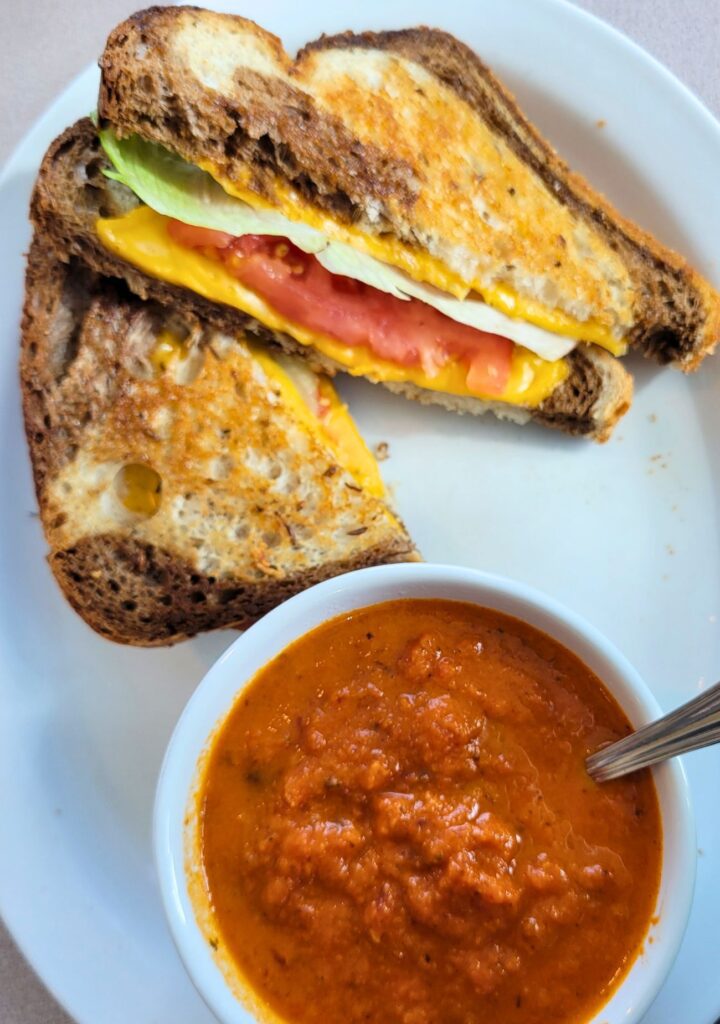
Ingredients To Make Marbled Rye With Fresh Milled Flour
- 4-4&1/2 cup Fresh Milled Flour 500g (I milled 400g hard white wheat and 100g of Rye Berries)
- 1&1/2 cup water 350g
- 2 TBSP softened butter 28g
- 2 TBSP maple syrup 43g (You can sub for honey or sugar)
- 1&1/2 tsp sea salt 9g
- 2&1/4 tsp active dry yeast
- 1 TBSP Carraway Seeds (You can increase this if you like a really strong Rye Bread)
Dark Dough Add-In After Dividing
- 1 TBSP Molasses 20g
- 1 TBSP cocoa powder 14g
Instructions To Make Fresh Milled Flour Marbled Rye Bread
Make The Dough
- Firstly, Mill the flour.
- To a stand mixer, add water, butter, maple syrup, Carraway seeds, and sea salt, then mix ingredients to combine.
- Then, add flour and active dry yeast to the stand mixer, and start to mix until all the dry flour is combined.
- Cover and let it sit at room temperature for at least 15 minutes, up to 2 hours to allow the fresh milled flour to absorb the liquid, and also for the bran to soften.
- Start the kneading process. This could take anywhere from 7-25 minutes with fresh milled flour. This varies greatly, so the best way to check if the dough is done being kneaded, is to check for a window pane test. You are just looking for nice stretchy dough.
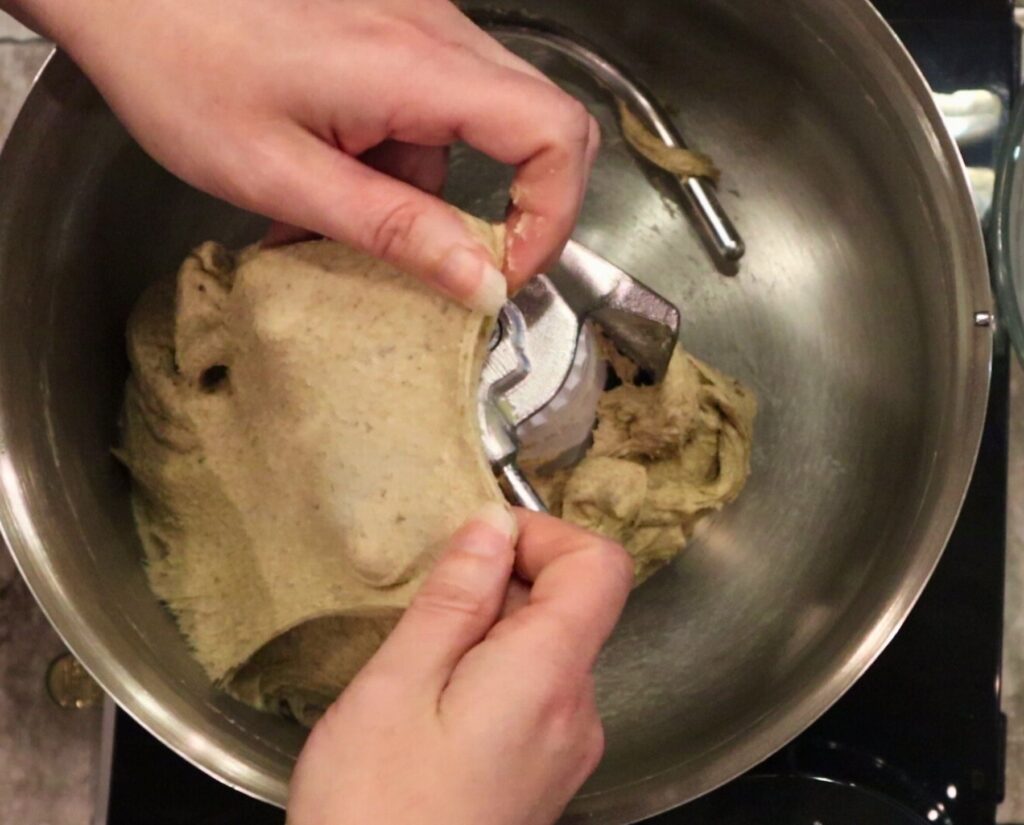
Divide The Dough In Half
- Once the dough is nice and stretchy, remove half the dough and place in a buttered bowl that is big enough to allow the dough to double, and then cover the bowl to allow the dough to rise. This will be your light rye portion of dough.
- The other half of the dough will be the dark rye portion. So, to dark dough portion, add molasses and cocoa powder. Knead those ingredients in, just until combined. (Don’t over knead the dough.) Cover this dough and allow it to rise.
- I go by my light dough, and watch for it to double. This will typically take 1 to 2 hours.
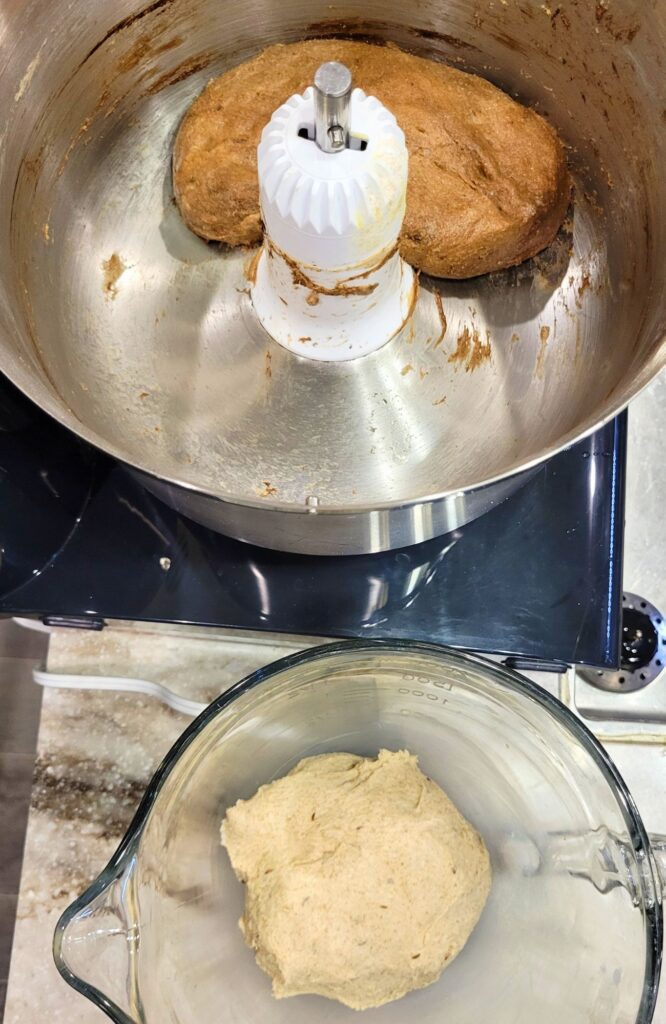
Roll Up The Dough
- Heavily butter your bread pan so your bread won’t stick, then place the shaped loaf into the prepared pan. (OR line with parchment paper)
- After the light dough has doubled in size, flatten the dough into a rectangle that one side is slightly shorter than your bread pan. I like to use some softened butter on my hands and work surface to shape the dough.
- Then, flatten the dark dough portion to a very slightly smaller rectangle. Lay the dark dough on top of the light dough. Roll the dough up with the shorter side of the rectangle facing you. So that when the dough is rolled up into a log, it will fit perfectly into your bread pan. I like to pinch the ends of the light dough over the dark dough. Place the rolled loaf in the prepared bread pan.
- Cover, and let rise for about 45-60 minutes until almost double, and puffy looking.
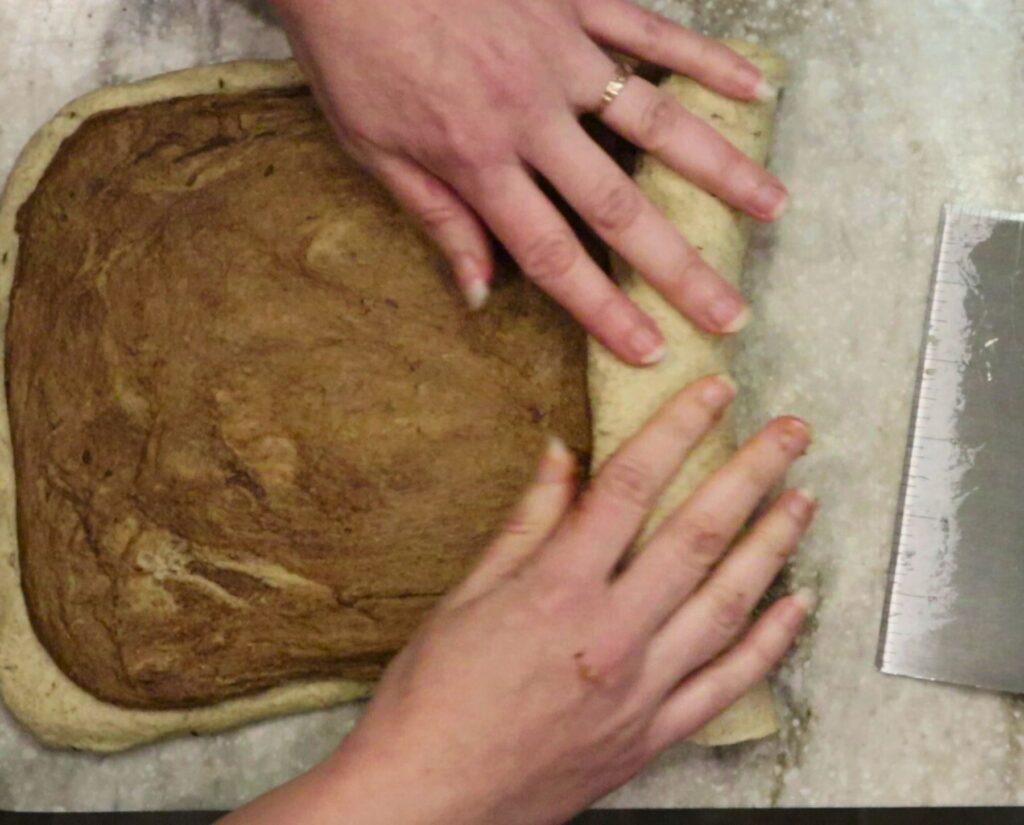
Bake The Rye Bread
- Preheat oven to 350*F towards the end of this second rise time.
- Bake for 45-55 minutes, until the internal temperature of the center of the loaf reaches 190*F.
- Remove from pan to a cooling rack, allow to cool at least 2 hours before slicing.
- Slice and enjoy!
How To Store FMF Marbled Rye Bread
How To Store- To store this FMF Marbled Rye bread, keep in an airtight container, or bag. Then, keep on the counter for 2-3 days. For longer storage, place in a freezer safe bag and freeze for up to 4 months. (Make sure the loaf has cooled completely before freezing, best results to freeze the same day as it is baked.) You can even slice the bread before freezing, so you can just grab what you need out of the freezer. To thaw, sit on the counter, and let come to room temperature.
Shop This Post
Nutrimill Impact Mill ($20 OFF Coupon Code: Grainy)
Bosch Universal (Black & Stainless) ($20 OFF Coupon Code: Grainy)
My Cook Book (paperback)
My Cookbook (hardback)
Shop My Site Wheat Berries & Coupon Codes
Baja Gold Salt SAVE 10% OFF with Coupon Code: Grainy
Check Out Some Of My Other Recipes
Brown Bread (Cheesecake Factory or Outback Bread copycat)
Fresh Milled Flour Recipe Index
Marbled Rye Bread Made With Fresh Milled Flour Printable Recipe
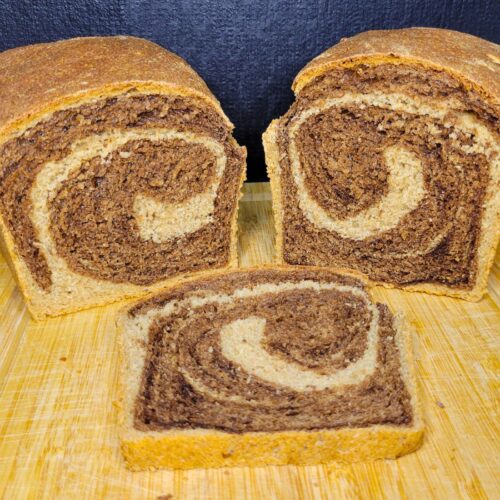
Marbled Rye Bread Made With Fresh Milled Flour
Ingredients
- 4- 4&1/2 cup Fresh Milled Flour 500g I milled 400g hard white wheat and 100g of Rye Berries
- 1&1/2 cup water 350g
- 2 TBSP softened butter 28g
- 2 TBSP maple syrup 43g You can sub for honey or sugar
- 1&1/2 tsp sea salt 9g
- 2&1/4 tsp active dry yeast
- 1 TBSP Carraway Seeds You can increase this if you like a really strong Rye Bread
Dark Dough Add-In After Dividing
- 1 TBSP Molasses 20g
- 1 TBSP cocoa powder 14g
Instructions
- Firstly, Mill the flour.
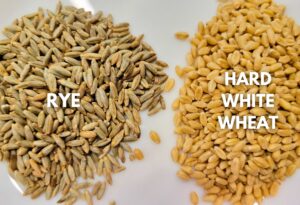
- To a stand mixer, add water, butter, maple syrup, Carraway seeds, and sea salt, then mix ingredients to combine.
- Then, add flour and active dry yeast to the stand mixer, and start to mix until all the dry flour is combined.
- Cover and let it sit at room temperature for at least 15 minutes, up to 2 hours to allow the fresh milled flour to absorb the liquid, and also for the bran to soften.
- Start the kneading process. This could take anywhere from 7-25 minutes with fresh milled flour. This varies greatly, so the best way to check if the dough is done being kneaded, is to check for a window pane test. You are just looking for nice stretchy dough.
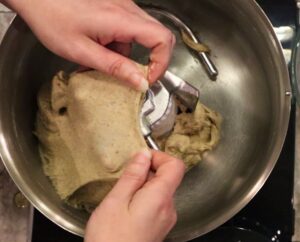
- Once the dough is nice and stretchy, remove half the dough and place in a buttered bowl that is big enough to allow the dough to double, and then cover the bowl to allow the dough to rise. This will be your light rye portion of dough.
- The other half of the dough will be the dark rye portion. So, to dark dough portion, add molasses and cocoa powder. Knead those ingredients in, just until combined. (Don’t over knead the dough.) Cover this dough and allow it to rise.
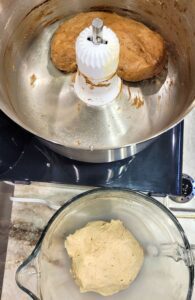
- I go by my light dough, and watch for it to double. This will typically take 1 to 2 hours.
- Heavily butter your bread pan so your bread won’t stick, then place the shaped loaf into the prepared pan. (OR line with parchment paper)
- After the light dough has doubled in size, flatten the dough into a rectangle that one side is slightly shorter than your bread pan. I like to use some softened butter on my hands and work surface to shape the dough.
- Then, flatten the dark dough portion to a very slightly smaller rectangle. Lay the dark dough on top of the light dough. Roll the dough up with the shorter side of the rectangle facing you. So that when the dough is rolled up into a log, it will fit perfectly into your bread pan. I like to pinch the ends of the light dough over the dark dough. Place the rolled loaf in the prepared bread pan.
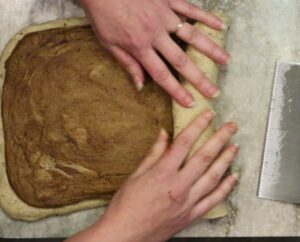
- Cover, and let rise for about 45-60 minutes until almost double, and puffy looking.
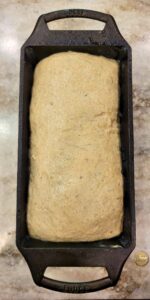
- Preheat oven to 350*F towards the end of this second rise time.
- Bake for 45-55 minutes, until the internal temperature of the center of the loaf reaches 190*F.
- Remove from pan to a cooling rack, allow to cool at least 2 hours before slicing.
- Slice and enjoy!
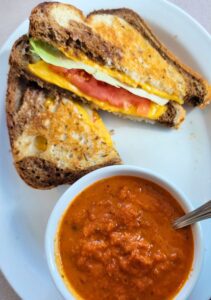
Video
Notes
*This post contains affiliate links, which means I make a small commission at no extra cost to you! Also, as an Amazon Associate I earn from qualifying purchases. But, I will only suggest items I actually Recommend!

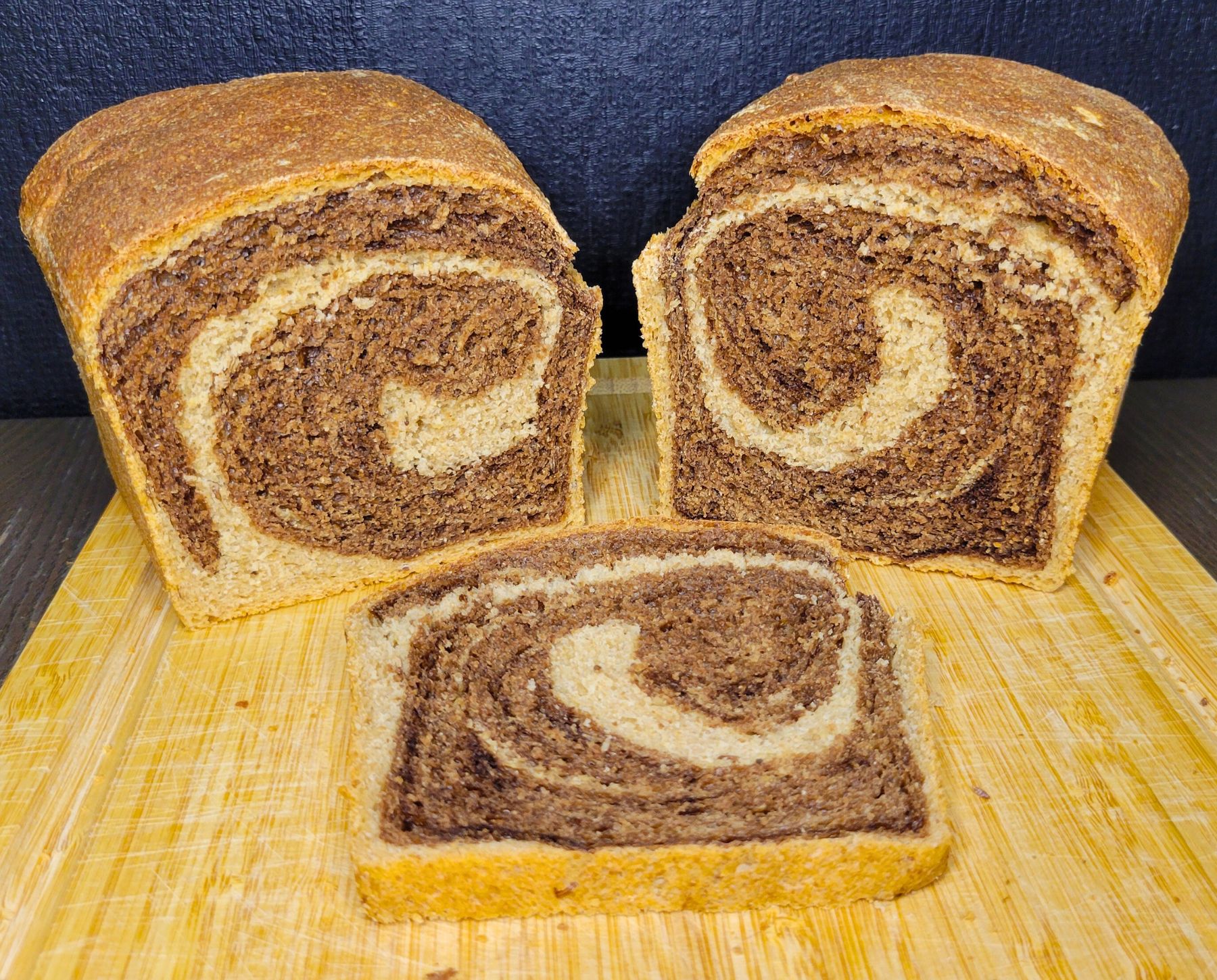


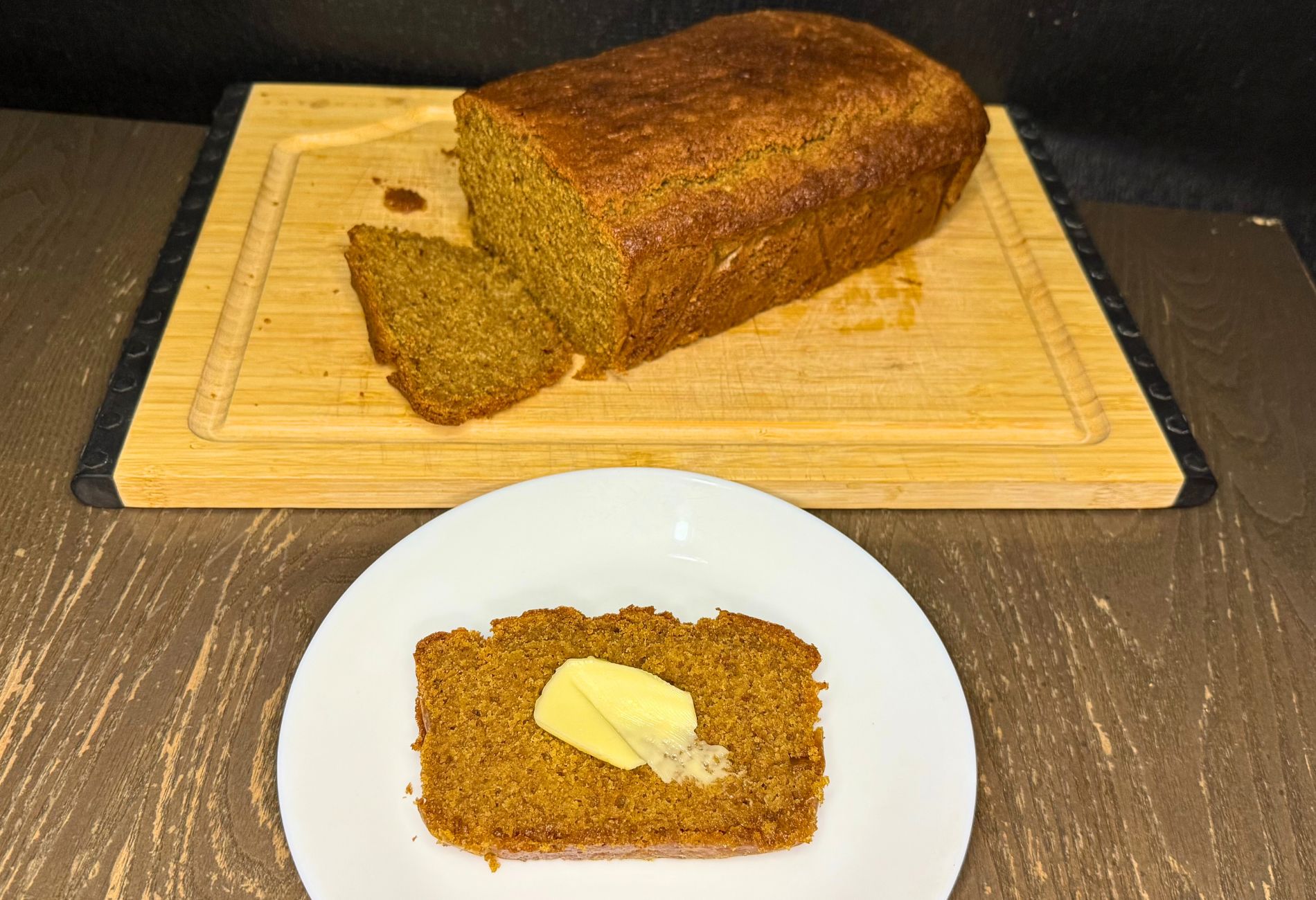


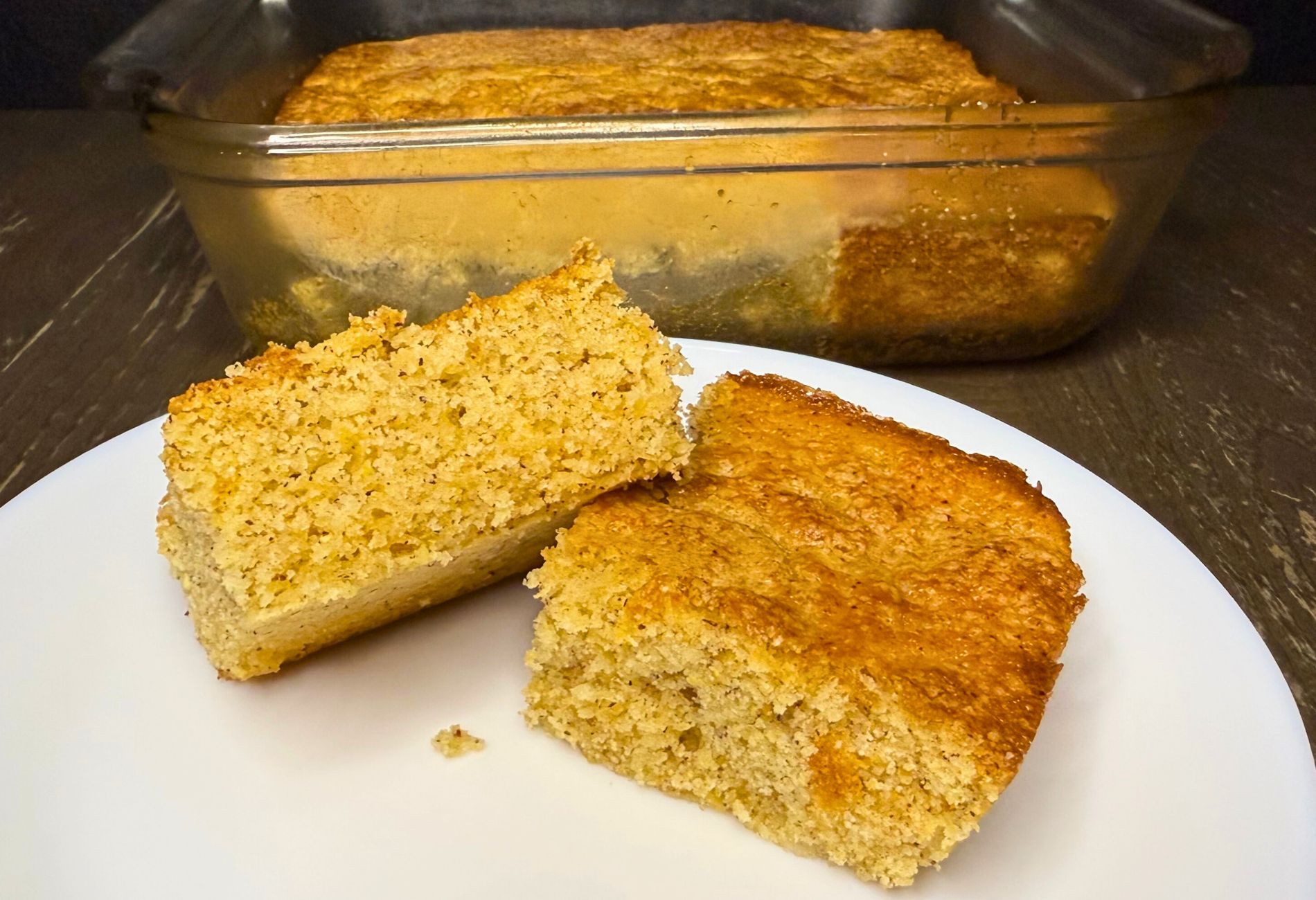

I’m watching the YouTube and noticed you said you forgot to add the egg, but in the recipe above there is no mention of egg(s). I am a bit confused.
(I love caraway rye. Can’t wait to make this bread.)
I forgot to account for the water in the egg. I didn’t want the egg in this bread, but when I reviewed my maple bread recipe, I had forgot to account for the moisture in the egg. Since I omitted the egg in this recipe, I had to increase the water. 🙂
My brain is less knotted now. Thanks for the explanation. 😀
🙂
How would you change the recipe to use sourdough starter in place of yeast? I only use SD. I think somewhere you gave a “formula” of sorts to convert from yeast to SD. If so, could you please give me that info again? Love your recipes and approach. Thank you
I would add about 1/2 cup active sourdough starter 115g, then watch the rise times they will be longer. Let me know how it goes. You may need to decrease the water in the recipe, so don’t add it all at once.
I converted this to sourdough by replacing the yeast with 100g of 100% hydration starter and then taking out 50 g of the flour and 50 g of water (except that I doubled the whole recipe so it was 200g sourdough, minus 100g flour and 100g water). I ended up doing 700g of the hard white and 200g of rye. I mixed the dough in the evening, let it rise overnight, then formed the loaves and let it rise in the pans for a few more hours, then baked it. It turned out great! Oh, also, I only did the dark dough except that I did not add the cocoa powder.
I haven’t made this recipe yet but, I noticed in step 3, it says to add the flour AND YEAST, then let sit up to 2 hours. All of your other (great recipes!), say to add the yeast after the flour absorbs the liquid.
I am making this tomorrow but, I will add the yeast after a half hour.
I made this bread with active dry yeast, so I added it with my flour so it could hydrate. You can of course, use my normal bread method that I use with instant yeast, and all other recipes. I have found it works great both ways! Thanks so much for noticing! 😉 Happy Baking! 🙂
Made this recipe, followed it to the T, and it was simple amazing!! My kids loved it too. It was easier to make than I thought it would be. The flavor is the traditional rye I was hoping for and expecting. Thank you for sharing.
Awesome! I am so happy to hear it was a hit! Thanks so much for sharing! 🙂
I doubled the recipe and it’s autolysing now. Should I double
The yeast? I love your notes when you say “don’t add more than a certain amount of yeast” bc I ALWAYS double your recipes. What’s the point of making one batch ! lol. Should I put 4 and half tsps?
Thank youuuu
I will double the recipe and double the yeast, it is when you go to triple and quadruple that you have to watch how much yeast to use. It will still turn out, it will just rise super fast. So, I like to double everything, but in a triple batch, I will just double the yeast, and add a pinch more. I hope that makes sense.
So I only have the instant yeast so I add the same amount as the active yeast?
Yes, the rise will be closer to the shorter time than the longer time with instant yeast
Hi Kara
I just made your rye bread and it was perfect! I didn’t do the marble and I used 2 tablespoons of caraway seeds! My husband and I loved it! Thank you!
I am so happy to hear that! Thank you so much! 🙂
Is the dough supposed to be sticky. I cannot get a windowpane with my Ankarsrum. He’p!
The dough should be somewhat sticky, what wheat are you using? If you haven’t had a chance to watch the video, I show the texture of the dough in that. I hope that helps! Here is the video, https://youtu.be/6-kodfoN9AE
Hard white. Palouse. Same weights as your recipe. The Ankarsrum was fitted with the dough roller. Should I perhaps have used the dough hook instead? After an hour on the Ankarsrum (way too long in my book), I still didn’t reach the golden ticket of elasticity. Feeling rather dumb here.
Watched your video 3 times. But it was a Bosch, so I couldn’t relate to its lightning speed. Me? In an Ankarsrum, it’s a slow-go.
Have no issues with WW loaves. But this one has one eyebrow raised high.
Hmmm, yes an hour is definitely too long, was it too dry? If so, it will never really come to a window pane, you can add a bot of water until it loosens up.
Really excited to make this. Would you be able to add a note at the bottom of the recipe stating how to make it with instant yeast? Not exactly confident in when to add and how to adjust rise times.
As long as you are not doubling the recipe, I use the same amount of yeast. For instant yeast, I will add that after step 4 (after the dough rests) then put it in at step 5 and start the kneading process. I find this little change makes the rise times be about the same. Instant yeast will typically rise a bit faster, and in a warm kitchen one hour for the first rise is typical for me, and 45 minutes for the second rise. If it’s cold in the kitchen, it may take longer. I hope that helps!
This marbled rye turned out great! Thank you for your tried and true recipes, Kara!
Awesome! I am so happy to hear that! Thanks! 🙂
Made this rye today. Baked nicely but fell in middle.. I do think I let it rise to much. When it got to the rest for 15 minutes it ended up being a lot longer and it had gone through a rise. Mixed it down and finished till I got the window pane. Then I let it rise. Put it into two smaller loafs. Rise again and bake. After baking a 20 minutes I looked through the oven door and it had fell in middle. Let it go to time and checked to see 190 degrees. took out and is cooling. Can hardly wait to cut it but will wait at least 1 1/2 hours. Did I let it rise too many times? Thank your
When a loaf collapses it is most likely caused by over proofing, so I would recommend shortening the second rise to prevent that from happening.
Cut my bread. Taste is wonderful. Maybe a little flat but works for us. Also got linen bag to put the bread in, but this morning seems like the cut end is dry (great for toast). Hint on best way to keep soft on counter before putting in freezer. Thank you again
We tend to slice ours when the loaf cools, and freeze any leftover slices right away to maintain maximum freshness. Some say the beeswax wraps are great, but I have not tried them myself yet.
After reading your tips I think I got the problem. Your recipe says to put the instant yeast in with the flour, mix and rest. But in your tips wait to put in the yeast when you start the kneading. Going to try that next loaf. Thanks for your reply.
Let me know how it goes! 🙂
Well made 2 more loafs of rye. Mixed the molasses and cocoa powder along with the flour. Let rest about 30 minutes. Then added the yeast and went through the kneading process. Got it nice and stretchy. Let it rise, punched down put in bread pans to rise again. Baked and seemed pretty good. BUT seems a little to light. Not as dense as I thought it would be. When cutting a slice just way to soft and comes a part. Help please.
It is a lighter fluffier style rye bread, if you want it a bit more dense, shorten the second rise time. 🙂
First, I want to thank you for such great recipes. I just made your snickerdoodles and they are fabulous. My question is- in the video you stated 1 cup of water or 240g but in the printed recipe it says 1 & 1/2 c or 350g, could you please clarify?
I started out in the recipe with the lower amount of liquid, because I had forgotten to replace some liquid for the egg. So, I ended up needing to add more liquid in the video later on. So, I updated the new liquid amount in the written recipe. You can leave a little liquid out in the beginning, and add it in if it seems a bit dry or tight.
I’ve been freshly milling flour for five years now and through MUCH trial and error still only have less than a handful of consistently good bread recipes. I love rye and after several fails, with a heavy heart and little hope thought I’d give yet another recipe a try. I did decide not to do the marbling and instead just added 2 T of molasses since the look of the bread doesn’t matter to me much. Let’s just say that I did just about everything wrong. I over kneaded, added too much flour, completely butchered shaping and this still turned out to be one of the most delicious loaves EVER! I couldn’t be more thrilled. I can easily correct my mistakes and may even add the marbling for the wow effect. I did add 1 T of caraway which for my taste wasn’t quite enough, but that’s a super easy fix. Thank you so much for this recipe. Can’t wait to try others. I’m even putting in an order for Kamut!
That is wonderful to hear! I am so glad it was a hit, and you learned how to improve it for the future! Awesome, Thanks 🙂
Hello Kara,
this was my first time using g Rye Berries what a delicious gorgeous loaf!!! I mixed with an ankarsrum mixer using roller and I used a tablespoon of vital wheat gluten. I chose to marble it and very happy with the results thanks for a wonderful recipe!!!
Yay! I am so happy to hear it was a hit! Nice job! I love the marble too it is so fun to see the results when cutting into it. 🙂
Just made this last night for Ruben sandwiches today. It was delicious!! The only thing I did differently was double the caraway seeds. My husband made the sandwiches and lightly toasted them in the oven for about 15min. Will definitely make again!! Wish I could post a pic, they were pretty! LOL!
Yay! I am so happy to hear they were a hit! Thanks so much! 🙂